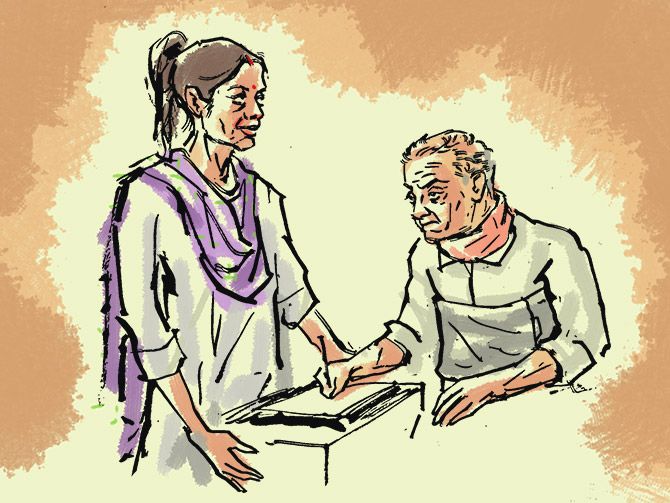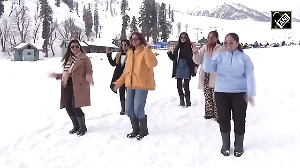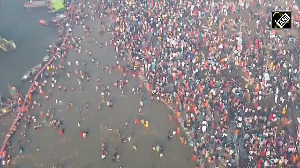This week was the first time Peter and Indrani appeared in court no longer married, footloose and fancy free once again, even if in jail.
Vaihayasi Pande Daniel reports from the Sheena Bora murder trial.
Illustration: Dominic Xavier/Rediff.com

Lawyer Sudeep Ratnamberdutt Pasbola must have had a rather peaceful and happy lunch post the Thursday October 10, 2019 hearing of the Sheena Bora murder trial as his morning couldn't have gone better.
Except that one hears he doesn't eat lunch usually.
From the defence point of view the pre-lunch cross examination of Nair Hospital senior forensic expert Dr Shailesh Chintaman Mohite unwrapped beautifully in CBI Special Judge Jayendra Chandrasen Jagdale's Courtroom 51 at the Mumbai city civil and sessions court at Kala Ghoda.
Dr Mohite, 52, Prosecution Witness No 58 continued to be the star witness, so far, of this lengthy, tedious trial, that has had its share of odd, weird and laughably-vague witnesses.
A short man, whose eyes are always in sharp, rapt focus on his subject, while speaking, and who wears thick spectacles, and a prominent wristwatch, Dr Mohite dresses neatly like a professional and has a manner to match.
The doctor endeared himself to you simply for the meticulous and duteous manner in which he offered opinions and answers. He carried to the box, each time, a set of several registers and notebooks that he consulted, carefully, at every turn, trying his very best to offer the most accurate answer to the court.
His answers were always definite and unambiguous and he conducted himself exactly as one would expect an expert with his vast experience would do so, his input credibly raising the standard and dignity of the trial.
When Dr Mohite didn't have an answer, which was not often, there was no odd humming and hawing, strange, sloppy evasiveness, creative storytelling, uncomfortable shuffling about in the witness box, examination of the ceiling or gazing interestedly, out of the stuffy room's perpetually closed windows, at the haughty contours of the 19th century Elphinstone college next door.
No. The outspoken doctor politely and immediately would say: "I do not recollect." And the 'cross' would move ahead.
A little rewind: Pasbola, Indrani Mukerjea's advocate, started his 'cross' of Dr Mohite on Wednesday. Dr Mohite is the professor and head of the department of forensic medicine at Topiwala National Medical College and the attached B Y L Nair Hospital, central Mumbai.
He was the doctor called in, in 2015, by the Khar Police station, north west Mumbai, to help with the exhumation of the skeletal remains, suggested to be Sheena Bora's, found near a mango grove in quiet, out-of-the-way Gagode Khurd, a village in Raigad, a fast-urbanising district of Maharashtra.
Dr Mohite concluded his long examination in chief late September, where before the court he examined and commented on each set of bones once more.
Through Wednesday and Thursday, as Pasbola exhaustively probed the forensic expert, across about four-and-a-half hours, a few important findings emerged.
Most of them, curiously and astonishingly, related to the earlier post mortem of the remains of what was said to be the same human body in May 2012 under the aegis of the Pen police station, Raigad, by another doctor Dr Sanjay Thakur, who has already appeared as a witness in this trial. In 2012 neither Thakur nor Pen police were able to identify the victim and, after extracting a few samples, buried the decomposed corpse. Dr Mohite entered the picture in 2015.
1. Pasbola first established the limits of Dr Mohite's forensic anthropological experience, which was not terribly vast, though he taught the subject. He also ascertained that Dr Mohite had never met an Indian forensic archaeologist.
2. Next Dr Mohite briefly described, on Pasbola's questioning -- perhaps to verify if the doctor's account matched other accounts -- the exhumation process (notably Dr Mohite's first) at Gagode Khurd which occurred on August 28, 2015.
The interesting part was that it was Dr Mohite who called a halt to the digging that rainy probably miserable monsoon day, after discovering just 86 bones of the body, not because no more bones could be located.
Pasbola waxing medically, several stout medical textbooks in front of him, even as his assistant Gunjan Mangla was studying the numerous luridly coloured diagrams of Marieb and Hoehn's Human Anatomy and Physiology: "A normal human being has at the time of birth 217 bones and after 18 or 19 years 206 bones because of the fusion of some bones. Doctor, the bones (you) recovered were less than 50 per cent. But it was your decision to stop the search (for more bones)?!"
Judge Jagdale commenting to himself, wonderingly and amusedly, on Pasbola's percentage figure: "(He has offered) a mathematical calculation."
Dr Mohite: "I would like to volunteer why I stopped. Yes it occurred to me to go on searching (he was in the pit) for the remaining bones. But the other bones, which were not recovered, (were) so minute that, at times, it became so difficult to get them. And since all important large bones of the body bearing medical significance in relation to the medical-legal (aspect of the case had been recovered)."
3. Pasbola interestingly uncovered too that while the specimens retrieved from Raigad were being examined by Dr Mohite and his team at Nair Hospital "in this particular case all the articles were in my custody under lock and seal."
Pasbola wondered why he had never told this to the CBI or the Khar police.
Dr Mohite said he was never asked.
Pasbola pointed out, with a laugh, that he had not asked either and Dr Mohite had volunteered this information on his own accord and then wryly and mysteriously commented to the judge, "There will be a lot of volunteering, my lord, in this case. Ultimately everybody has to my lord...."
Earlier he had interrupted the judge when he was dictating for the court record: "It is correct to say...."
Pasbola: "Not 'correct to say'. Nothing is correct in this case!" And judge and lawyer smiled together at the little joke.
4. Amazingly it was revealed, through deft querying by the astute lawyer, that during the first post mortem conducted by the Pen local Dr Sanjay Thakur in May 2012, after the discovery of a semi-decomposed corpse, as many as 43 pieces of bone had been extracted and sent to the Pen police station and from there to the J J Hospital, south Mumbai.
Through his chief and cross Dr Thakur gave the impression that he had only removed just a few and had been sketchy about which bones.
5. More amazing and bewildering was that these bones were not particularly relevant according to Dr Mohite because they may not have been from the same skeleton or of a human being!
Dr Mohite told the court: "Some of the bones were in size of particles therefore, I have not counted... Some of the bones, which could be counted were 43 pieces of bone... I cannot say as to how many bones these 43 pieces were comprised."
"We have not tried to match the set of bones with each other (to see if they were) of the same individual or not. I have not done it because, there were few animal bones in the jar sent to us."
"Also (in examples he illustrated) upper end of fibula (lower leg bone) did not belong to the skeleton exhumed from jurisdiction of the Pen police station as the right and left fibula was already present in that skeleton... We had already recovered the left first rib from the exhumation site, therefore, it could not be of the same individual."
"In view of duplication of bones, some of the bones could not have been of the same person whose skeleton we have exhumed from Gagode Khurd. It is difficult to say if these multiple identifiable bone pieces belong to one or more individuals."
6. In an attempt to establish the validity of these eroded bones belonging to the first set, put together by Dr Thakur, that were sent to Dr Mohite by the police from JJ Hospital, for re-examination, Dr Mohite had suggested at the time (2015) that a precipitant test be done.
Medically-armed Pasbola: "A precipitant test is done to determine if the bones are of an animal or a human?"
Dr Mohite agreed.
Pasbola: "These bones you have seen were also eroded?"
Dr Mohite: "Yes sir, they were eroded."
Pasbola: "And from these bones you could not detect the age or sex of the person?"
Dr Mohite: "Yes sir."
7. There was additional disparity between both sets of bones (what Dr Thakur collected and what Dr Mohite exhumed). Said Dr Mohite: "The skeletal remains (recovered) on 28/8/2015 from Pen jurisdiction did not show such extent of charring as was noticed in the skeletal remains from the samples received from J J Hospital."
Nor did the teeth match ("All the teeth collected from J J do not belong to the maxilla and mandible of the skeletal remains recovered by exhumation from the jurisdiction of the Pen police station.")
8. Further the damage and erosion made it also impossible to determine the time since death of Dr Thakur's set of bones.
Pasbola had Dr Mohite detail the factors that help determine the time since death. These included the presence/absence of muscular attachments and ligaments, smell and dryness of the bones, as well as erosion.
These in turn, Pasbola requested Dr Mohite to confirm, depended on environmental factors like climate, if a body was buried, if a body was clothed etc.
Step by step Pasbola hammered out with Dr Mohite how long it takes for bones to lose their muscular and ligamental attachments and for the smell to disappear.
Dr Mohite cautiously offered that this process -- which depended on numerous additional conditions, beyond those already listed, like even body build, illness, attacks by animals -- occurred completely in between one to six months for muscular attachments, a little more than that for ligaments, while smell vanished when the bones were no longer moist, after about 1.5 to 2 years.
"Once the muscles start to detach (within 24 hours) a foul smell starts."
It would seem that the bones Dr Thakur unearthed might have been much older
9. Pasbola turned the focus of the cross to the evidence of strangulation and smothering in the skeletal remains the Nair doctor had exhumed. He first wondered if Dr Mohite had been aware of the cause of Sheena Bora's death before he was enlisted for the task of exhumation -- that the "victim had allegedly been strangulated or smothered."
Dr Mohite: "I had read about it in the media."
Pasbola: "So you were looking at the cause of death from that angle?"
There was a little backwards and forwards wrangling on that point till Dr Mohite finally said conclusively and primly: "We have looked at all causes of death including strangulation." Smothering, he specified, was different.
Pasbola then, in the same rigorously thorough manner, so the point was nailed down loud and clear, repeatedly, through his line of questioning to Dr Mohite, made the court aware that a cause of death was not determinable.
"Yes sir, examination for injuries, fractures, foreign bodies or anything of foreign nature in the mouth cavity, were carried out. We look for fracture of neck vertebrae (when we) look for signs of strangulation... Examination of injuries in the neck region, haemorrhaging, laceration of neck muscles, and fracture of underlying hyoid bone and other laryngeal cartilage is essential to determine the cause of death to be manual strangulation."
Pasbola subsequently, a little later reconfirmed with Dr Mohite: "So you took into account all aspects of natural and unnatural death?"
Dr Mohite categorically: "But we could not come to any findings whether the death was natural or unnatural even after considering all available resources."
10. Finally Pasbola asked Dr Mohite about skull autopsies and how long it takes for the brain to liquefy and ooze away so there are no traces.
Pasbola: "Now doctor, you are the head of your department and must have conducted several post mortems where where you cut open the skull? Several thousand probably?"
Dr Mohite agreed.
Pasbola: "To examine the brain? A circular cut?"
Dr Mohite: "Yes."
A little later Pasbola asked: "There was no circular cut by you in the skull (exhumed at Gagode Khurd) as made during an autopsy. As far as was seen skull was intact?"
Dr Mohite in a definite tone: "Yes sir."
It was as this point that the cross for Thursday ended.
Till date, the cross-examination of Dr Mohite by Pasbola has been a battle of equals, an encounter between professionals, senior lawyer vs senior doctor, with mutual respect seeming to govern their interactions.
Dr Mohite politely addressed Pasbola as "Sir" throughout and Pasbola always referred to the Nair expert as "Doctor."
They were good humoured interactions too. Even when they both didn't agree on an answer or Dr Mohite's manner of answering a question, each would smile at each other and crack a laugh.
Friction was virtually missing. Voices didn't get raised. Nor the temperature of the room (beyond the stifling 36 degrees it is normally at, because of lack of ventilation that has one dripping with sweat through the hearing).
At times a curious Dr Mohite would quizzically cock his head at Pasbola, searching his face, trying to understand or absorb either the general legal way of doing things or Pasbola's unique method.
Dr Mohite's fastidiousness appeared to tickle Pasbola for whom, perhaps, considerably more professional witnesses were few and far between in his court life.
Net result: The usually impatient Pasbola, who gets immediately tetchy when he has to suffer fools, was in an expansive mood, his moveable face registering mostly good humour and charm, as the cross examination travelled along on the particular path he had devised for it, not meandering much or getting derailed.
At the end of the proceedings the various lawyers checked up on the status of various applications put in for their clients. Accused No 2 Sanjeev Khanna was awaiting permission to update his passport.
Indrani was looking for the response to her six-month old bail application. And she got it.
The answer though probably no doubt disappointing didn't seem to surprise her much.
Basically the reply said the trial was at a key juncture with important witnesses expected and it would not be wise for a person of her influence to be out on bail.
Nor had the circumstances changed any from the time when she had filed her previous two applications and her health issues, for which special provisions had been made, had not altered to require a reconsideration of her appeal for bail.
This week was the first time Peter and Indrani appeared in court no longer married, footloose and fancy free once again, even if in jail. They signed a few bank papers together.
Peter, in spite of the chest brace and the neck brace he wears to protect his spine from the bumpy ride to and from Arthur Road jail, south central Mumbai, looked quite happy about it, terming the occurrence to a bystander as magical.
Indrani, still sporting sindhoor, also maintained her usual equanimity, lively and smiley, in turn, and told a visitor that things were "All good."
Indrani's lawyer Gunjan Mangla went home lugging two to three medical textbooks.
No doubt she and Pasbola, as aspiring doctors, will be burning the midnight oil, updating themselves on the ABCs of epiphyseal plates, ossiputs, endosteums, bregmas, fibulas-tibulas and what not else in human anatomy.











 © 2025
© 2025